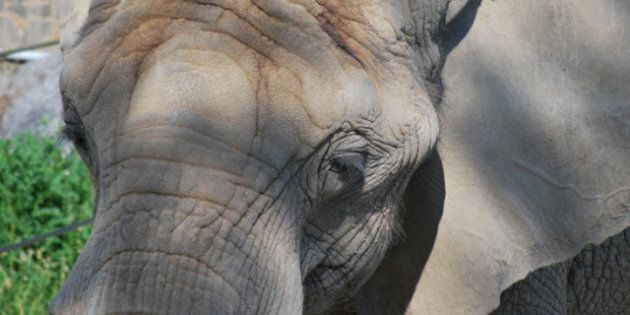
It has been a good week for animals in Toronto. Not only did Toronto City Council vote on Tuesday to ban shark fin products, but council also made the laudable decision to retire the Toronto Zoo elephants to the Performing Animal Welfare Society (PAWS) sanctuary in California. For the three surviving female African elephants -- Iringa, Toka, and Thika -- I think this vote makes the difference between a life of ongoing misery and a life of relative comfort. The elephants can now live out the rest of their lives away from the cold confines of a Canadian zoo. Instead of waking up to steel bars and spectators in the morning, the elephants will now roam free in expansive natural areas where they can enjoy life while grazing, exercising, and interacting with other elephants.
The ethical dimension of confining elephants in zoos has generated a great deal of debate recently in Canada. At the heart of the ethical concerns, of course, is the welfare of the elephants. A growing body of evidence has many elephant experts contending that it's simply not possible to meet elephants' basic physical and psychological needs in an artificial, zoo-like environment. We know that zoo elephants frequently suffer from captivity-induced health conditions not seen in their wild counterparts, such as foot infections, obesity, arthritis, and psychological ailments. Elephants held captive in Canadian zoos face additional welfare concerns, as our cold climate means the elephants are either kept indoors for a sizable chunk of the year, or forced to endure the frosty air. Elephants have evolved to live in temperate and tropical climates; they are not adapted to cold weather.
Seven elephants have died at the Zoo since 1984.
The saga of the Toronto Zoo elephants has been a lengthy one. The Toronto Zoo Board accepted a recommendation to end its elephant program earlier this year, but this positive news for the elephants was overshadowed by the Board's reluctance to relocate the three African elephants to a sanctuary. The Board rejected suggestions that the aging elephants' welfare could best be assured by sending them to a spacious sanctuary in a warmer climate. Instead, they wanted the elephants to simply be transferred to another zoo accredited by the Association of Zoos and Aquariums (AZA).
Luckily for the elephants, Toronto City Council showed compassion on Tuesday. In a late night vote, Councillor Michelle Berardinetti's motion to send the elephants to the PAWS sanctuary passed with strong support -- by a 31 to 4 margin.
This historic decision is undoubtedly the best one for the Zoo's elephants. Sanctuaries have high standards of care and welfare for the animals they shelter, providing a far richer and more meaningful life for elephants than zoos ever could. The PAWS sanctuary exceeds zoo standards in every way imaginable, offering over 80 acres of natural land for the elephants. Meanwhile, the AZA minimum outdoor space for one adult elephant is a mere 1,800 square feet, or about the size of nine standard parking lot spaces. And although the Zoo Board decided the elephants should not go to facilities that use the cruel and painful bull hook, there was no guarantee that the new facility could not then hand the elephants over to another institution that does physically abuse the animals.
The three Toronto elephants have been given a second lease on life, but this recognition that elephants are better off in a sanctuary has broader implications for elephants in captivity elsewhere. The Edmonton Zoo has been in the public spotlight for years over its refusal to retire its lone and ailing elephant, Lucy, to a sanctuary. Lucy's sad story has attracted celebrity supporters like Bob Barker, and is the subject of an ongoing court case, which may soon be heard by the Supreme Court of Canada. Meanwhile, elephants used in circuses spend their lives in pens or on chains, are trained using cruel negative reinforcement, and are forced to travel long distances and perform unnatural tricks.
Elephants are in zoos in the first place because of our fascination with and love for these majestic animals. However, it's time to recognize that elephants are intelligent, sensitive creatures whose physical, psychological and emotional needs simply cannot be met in zoos. Releasing captive elephants to sanctuaries is the best way to express our own values of compassion for animals. Acting on the will of its citizens, Toronto City Council showed great leadership by prioritizing the best interests of Iringa, Toka, and Thika. Let's hope the citizens and politicians in Edmonton and other cities that operate zoos find the courage and empathy to follow suit.